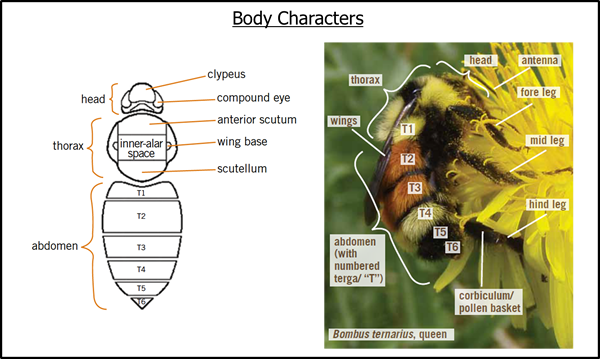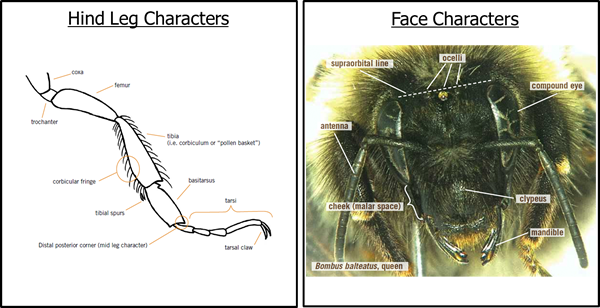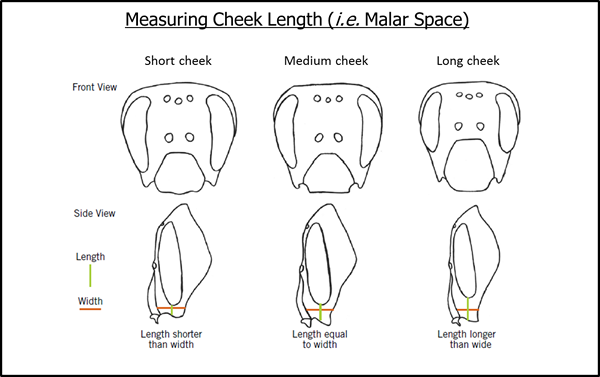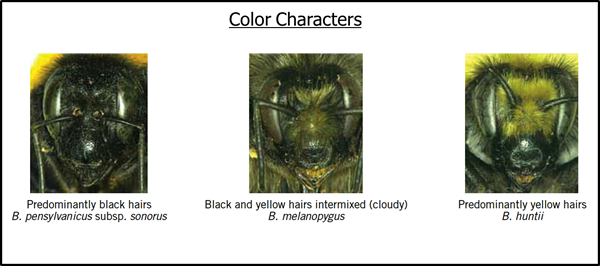Bumble Bees of Montana
Female Morphology
Our Key to Montana Bumble Bees is to female bumble bees only. To key out males, we recommend Bumble Bees of North America (Williams et al. 2014). The key includes all 28 species recorded from Montana along with four species that might be found here. Morphological characters used in the key are shown in the figure found at the bottom of this page and key terms are defined below. When color is used in the key, it is referring to the color of the body hairs unless otherwise stated.
One of the most challenging characters used to key out bumble bees is the length of the malar space (i.e. cheek) compared to its width. The length of the cheek is measured from the lower margin of the compound eye to the attachment of the mandible. The width of the cheek is measured below the compound eye and is the distance from the margin of the gena to the margin of the clypeus (see Measuring Cheek Length Figure), which is best viewed in profile. In general there are three cheek lengths: 1) shorter than wide, 2) approximately as long as wide and 3) longer than wide. There is considerable variability within these categories, and it takes practice to learn to identify these with confidence. After keying out a specimen, we recommend reading the species description and diagnosis to confirm your determination.
Definitions
Anterior scutum: The dorsal surface (i.e. top) of the thorax anterior to the wings (Body Characters Figure).
Basitarsus: The leg segment between the tibia and the tarsi (Hind Leg Characters Figure).
Cheek/malar space: The space between the compound eye and the attachment of the mandible (Face Characters and Measuring Cheek Length Figures).
Clypeus: The region of the face below the antennal bases and above the mouthparts (Face Characters Figure).
Corbicular fringe: The long hairs that surround the corbicula/pollen baskets on the hind tibiae (Hind Leg Characters Figure).
Corbiculum: “Pollen basket”; The shiny, concave portion of the hind tibia (Hind Leg Characters Figure).
Coxa: The segment of the leg that attaches to the thorax (Hind Leg Characters Figure).
Gena: The side of the head below the eyes (Measuring Cheek Length Figure).
Interalar band/space: Area between the wings (Body Characters Figure).
Metasoma: Referring to the third body segment (i.e. the abdomen; Body Characters Figure).
Occiput: The top of the head.
Tergite/terga/T1-T6: The segments on the dorsal surface (i.e. top) of the third body segment (i.e. abdomen). Tergal segments are counted starting from where the abdomen connects to the thorax (Body Characters Figure).
Scutellum: The dorsal surface (i.e. top) of the thorax posterior to the wings (Body Characters Figure).
Sternite/sterna/S1-S6: The segments on the ventral surface (i.e. bottom) of the third body segment (i.e. abdomen). Sternal segments are counted starting from where the abdomen connects to the thorax.
Click to go to the Key for the Bumble Bees of Montana




Used with permission from Koch et al. 2012
